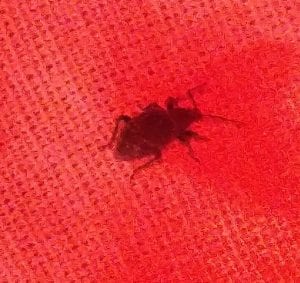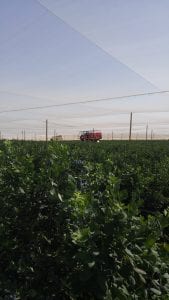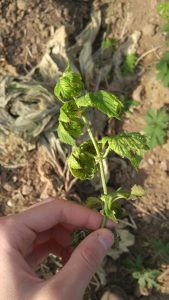My last two weeks in Washington were spent working at various vineyards that are managed by Two Mountain Winery in Zillah. The vineyards at Two Mountain and those that they manage are very unique because the majority of their vines do not need to be planted on grafted rootstock. The majority of the world’s Vitis vinifera varieties are planted on grafted rootstock that is more resistant to a root pest called phylloxera. Phylloxera can be very damaging to a vineyard especially when planted on original rootstock. However, this one particular area in Washington is one of the only places that is void of phylloxera, therefore allowing original rootstock to be planted.
Horizon at Two Mountain Vineyards
My purpose for working at Two Mountain was to utilize my IPM expertise and develop an IPM plan that they can use in future years so that they don’t have to hire someone to scout for them. I was able to put together a plan that focused on the most important pests and diseases found in this region’s vineyards, which included two-spotted spider mites, mealybugs, powdery mildew, red blotch, leaf roll, and botrytis. I developed scouting densities based on the sizing of each block and varied the number of leaves sampled depending on the layout of the block.
Leaf with Red Blotch Identified by Red Veins
Mealybug
Along with the development of an IPM Guide, I took cluster counts to determine which blocks needed fruit cluster thinning. I also scouted one ten acre block, row by row, tagging all vines that had red blotch symptoms, so that they could be removed in the fall and replanted in the spring. Lastly, I learned to operate a forklift and helped sort harvest bins for each of the wineries to come and collect before harvest.
I truly am grateful for having this experience at Two Mountain and for spending the summer working with the hops at Perrault Farms. I discovered that I liked working in the hops a lot more than I anticipated to and that I really enjoyed scouting for pests and learning about the different pests and diseases. This summer is definitely one that is going to help shape my future career.








 each field into thirds and chose a lane to take our counts from. We stopped at three points in our row, laid out a tarp, and beat the back of a bine with a stick to see how many weevils fell out. We recorded the number of weevils that fell onto the tarp. There were only a few fields that had relatively high counts and control methods have yet to be determined.
each field into thirds and chose a lane to take our counts from. We stopped at three points in our row, laid out a tarp, and beat the back of a bine with a stick to see how many weevils fell out. We recorded the number of weevils that fell onto the tarp. There were only a few fields that had relatively high counts and control methods have yet to be determined.


















